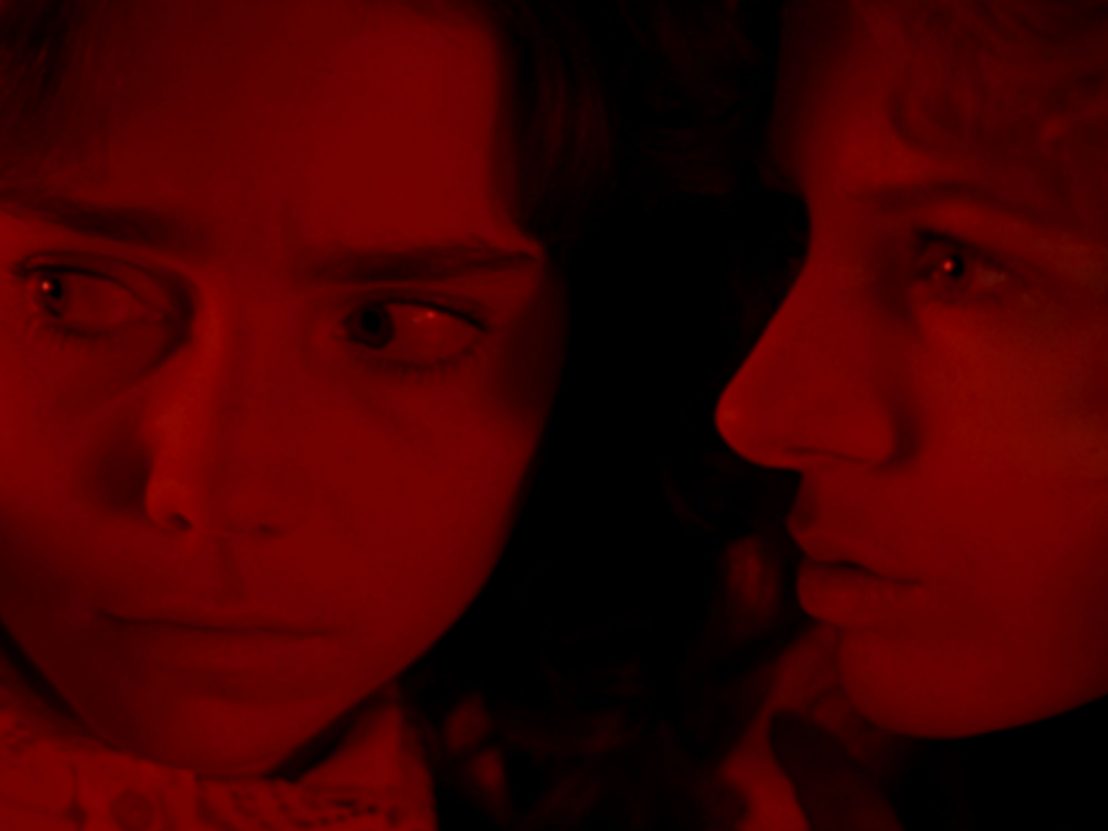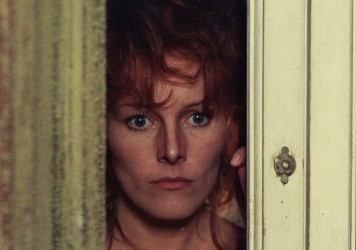
Suspiria begins with an arrival, and an entrance. Hoping to perfect her ballet studies at Europe’s most famous Dance Academy, American Suzy Bannion (Jessica Harper) has just landed at the airport in Freiburg, Germany on a wet and windy night. As she approaches the glass automatic doors leading outside, the film repeatedly switches between a medium shot tracking Suzy’s walk through the airport’s lobby (accompanied only by the airport’s naturalistic noise), and her own POV shot of the automatic doors ahead (accompanied by the seductive tinkling of Goblin’s score).
Here, through the manipulation of sound alone, director Dario Argento conjures both the normality that Suzy is leaving behind, and the enchanting fairy tale world beyond that she is about to enter. As she passes through, there is a disconcerting and disorienting cut to the doors’ electric mechanism operating as they open and close again – and Suzy is out, in the harsh elements, soaked and alienated and struggling to hail a taxi. From this point on, Goblin’s wailing, strident prog rock score – all susurrations and strums and pounding rhythms, like nothing ever heard before in a horror film – becomes the near ever-present soundtrack to Suzy’s nerve-shattering bewitchment. This is a film whose overwhelming effect can only truly be experienced with the volume turned way up.
In fact Suspiria is a story not of one outsider in Freiburg, but of two. The other is Helena Markos (an uncredited Lela Svasta), a Greek migrant who came to Germany under a cloud at the turn of the century, constructing the Tanz Akademie as a home for herself and her extended family, and who, despite being presumed dead, has ever since been corrupting the city, step by step, in her own vicious (if concealed) image. Seen fleeing the Academy just as Suzy arrives, Pat Hingle (Eva Axén) is only the latest student to try escaping Markos’ sinister clutches.
But as the Escher prints on the walls of the Art Deco apartment where Pat seeks refuge suggest, here all of Freiburg is a deadly labyrinth of illusions. Pat suffers a horrific death at the hands of an irrational, demonic force, and now Suzy, effectively Pat’s replacement at the school, seems destined to meet with the same wicked fate – but the curious, wilful young woman is determined to unravel what is going on at the Academy, and to confront and expose what cannot be explained or even seen.
Argento’s gialli often involved strange slices of pseudoscience (like the factoid from 1971’s Four Flies on Grey Velvet that the human eye retains an imprint of the last thing it saw before its host died), but Suspiria was his first foray into the full-blown supernatural. Lit by DoP Luciano Tovoli in garish reds, blues, greens and yellows, the film creates a world of queasy artifice that induces something like a hallucinatory synaesthesia in the viewer, to match Suzy’s own increasing sense of nausea and entrapment. The Academy is a place of sickness and rot, causing a mysterious illness in Suzy, and at one point even becoming infested with maggots.
It’s also a deathtrap, and a maze, with hidden interiors and deadly spaces – and the bodycount continues to rise, made of anyone who defies the will of instructors Miss Tanner (Alida Valli) and Madame Blanc (Joan Bennett). Everything draws Suzy closer to Markos, as the student, like some folkloric detective, follows a series of absurd narrative breadcrumbs to the elusive directress’ location. In that secret room, wizened evil will wrestle with innocent youth, and fairy tale logic will prevail, even as Suzy accidentally overturns and breaks an ornamental glass peacock in a symbolic act ultimately signalling Argento’s departure from the methodology of his earlier crime films (his 1970 directorial debut was called The Bird With The Crystal Plumage).
Suspiria has been very influential, inspiring two direct sequels (Inferno in 1980 and Mother of Tears in 2007) and many a witchy fantasy or tale of balletic breakdown from other directors. It has even spawned a long-gestating remake due for release in 2018. Yet it is also, paradoxically, an inimitable singularity – a mesmerising, if confounding, danse macabre that treads that strange terrain between the psychological and the magical. It certainly marked the arrival of Argento as a master not just of the stylised murder set-piece (for he had already achieved that with his earlier, more conventional gialli), but also of the sensual and the surreal. Suspiria is a baroque piece of esoteric expressionism that you enter – and exit – without understanding so much as feeling.
Suspiria is released by CultFilms on dual-format special edition Blu/DVD in a 4K restoration on 4 December.
Published 4 Dec 2017

By Amy Bowker
The Radiohead frontman will provide music for Luca Guadagnino’s upcoming re-imagining of Dario Argento’s cult classic.

Iconic stars like Anita Strindberg and Edwige Fenech are the thread that ties this deviant subgenre together.

By Adam White
Wes Craven’s seminal 1996 film occupies a uniquely female space.